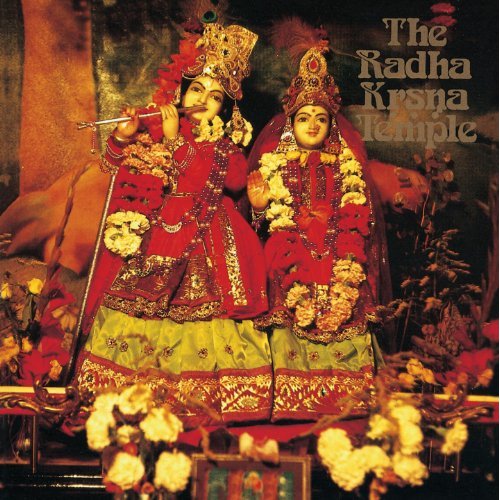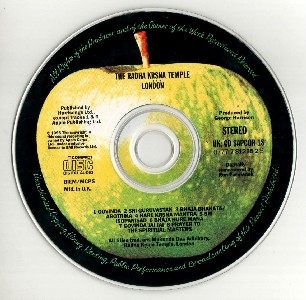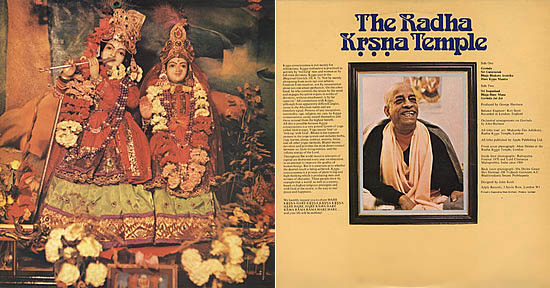The verses 30 and 32 from the Brahma-samita are sung in the morning Srngara Arati in all ISKCON temples, while the first track of the 1970 album “Radha Krsna Temple” is played. Srila Prabhupada enjoyed this track very much and was so moved that he said that this track will play at all ISKCON temples for the Srngara Arati. As a result, no one ever leads kirtan for this song, as it is played through that track.
Govinda
The Radha Krsna Temple Album
Sung by Yamuna devi
Produced by George Harrison
venum kvanantam aravinda-dalāyatāksam-
barhāvatamsam asitāmbuda-sundarāngam
kandarpa-koti-kamaniya-viśesa-śobham
govindam ādi-purusam tam aham bhajāmi
veṇum—the flute; kvaṇantam—playing; aravinda-dala—(like) lotus petals; āyata—blooming; akṣam—whose eyes; barha—a peacock’s feather; avataṁsam—whose ornament on the head; asita-ambuda—(tinged with the hue of) blue clouds; sundara—beautiful; aṅgam—whose figure; kandarpa—of Cupids; koṭi—millions; kamanīya—charming; viśeṣa—unique; śobham—whose loveliness; govindam—Govinda; ādi-puruṣam—the original person; tam—Him; aham—I; bhajāmi—worship.
I worship Govinda, the primeval Lord, who is adept in playing on His flute, with blooming eyes like lotus petals with head decked with peacock’s feather, with the figure of beauty tinged with the hue of blue clouds, and His unique loveliness charming millions of Cupids.
angāni yasya sakalendriya-vrtti-manti
paśyanti pānti kalayanti ciram jaganti
ānanda-cinmaya-sad-ujjvala-vigrahasya
govindam ādi-purusam tam aham bhajāmi
aṅgāni—the limbs; yasya—of whom; sakala-indriya—of all the organs; vṛtti-manti—possessing the functions; paśyanti—see; pānti—maintain; kalayanti—manifest; ciram—eternally,; jaganti—the universes; ānanda—bliss; cit—truth; maya—full of; sat—substantiality; ujjvala—full of dazzling splendor; vigrahasya—whose form; govindam—Govinda; ādi-puruṣam—the original person; tam—Him; aham—I; bhajāmi—worship.
I worship Govinda, the primeval Lord, whose transcendental form is full of bliss, truth, substantiality and is thus full of the most dazzling splendor. Each of the limbs of that transcendental figure possesses in Himself, the full-fledged functions of all the organs, and eternally sees, maintains and manifests the infinite universes, both spiritual and mundane.
Purport
By His Divine Grace A.C. Bhaktivedanta Swami
November 5, 1966 New York, NY, USA
So this is the original nature of Krsna, original nature of Krsna. He is Radha-Madhava. He is the lover of Srimati Radharani. The materialistic demeanor cannot possibly stretch to the transcendental autocrat who is ever inviting the fallen conditioned soul to associate with Him through devotion or eternal serving mood. The phenomenal attractions are often found to tempt sentient being to enjoy the variegated position which is opposed toundifferenced monism. People are so much apt to indulge in transitory speculation even when they are to educate themselves on the situation beyond their empiric area or experiencing jurisdiction and almost foolishly they dare to declare that God is dead. The songs of Brahma-samhita as cintamani-prakara-sadmasu, will surely help such souls in their march toward the Personality of Godhead in the spiritual kingdom which is lying beyond their sensuous gaze of inspection.
The so-called astronomers cannot even definitely give us information of the visible sky which is overflooded with sunlight during daytime and moonlight at night. We can, however, learn about spiritual kingdom from theBhagavad-gita that it is situated far, far beyond the visible sky and in that sky there is no need of sunlight or moonlight or even electricity. There are innumerable spiritual planets in that self-effulgent sky, and the gross estimate of that sky is given in the Bhagavad-gita that the material world wherein there are innumerable suns and moons is only one-fourth of the whole kingdom of God. This material world is also part of the kingdom of God, but this kingdom of God is described as made of inferior energy on account of its temporary nature and is compared with a mass of clouds in the sky. When there is a mass of clouds in the sky, there is certainly torrents of rain and there is a type of creation of new vegetation on account of such rainfall. But in spite of all such variegated-ness, manifestation of greenery seen, of fruits and flowers, the whole show is only temporary. When the season is over, everything fades away into different situations and the temporary manifestation come to an end.
Therefore, the material world is called three phases of existence, namely creation, sustenance, and dissolution at last. This creation and dissolution is going on perpetually like seasonal changes, and the portion of the vast sky where such temporary variegatedness is taking place and again becoming out of sight is called the material world. And beyond this material manifestation of variegatedness, there is the world of spiritual sky where everything is eternal, full of life, blissful and knowledge distinct from the non-eternal, miserable existence of ignorance. In the material world everything is struggling hard for existence, but the cruel laws of material nature will not allow anybody to exist although everyone of us aspires to exist eternally in full blissful life of perfect knowledge.
This information is available in the Brahma-samhita that the Supreme Personality of Godhead is Krsna, and His transcendental form is eternal, full of bliss and knowledge. In the spiritual world, not only Krsna has His eternal body full of bliss and knowledge, but also everyone who associates with Krsna has the same spiritual nature. In the abode of Krsna, which is called Cintamani-dhama, the land, the trees, the animals, the residents, everything is of the same spiritual nature as that of Krsna. This spiritual nature is expansion of interior energy of the Supreme Personality of Godhead. Therefore, the Supreme Personality of Godhead, Krsna, is called the cause of all causes.
It is said that Brahma, who wrote Brahma-samhita after his mature knowledge by meditation, it was revealed in him that by the recollection of bhakti-yoga, it appeared to him that he is the eternal maid-servant of Krsna. Though other mysteries in regard to the condition of the maid-servant of Krsna were not revealed to him, Brahma, by dint of his searching self-consciousness, became well acquainted with the ocean of truth. All the truths of the Vedas were revealed to him and with the help of those essence of the Vedas, he offered this hymn to the Supreme Lord Sri Krsna. Sriman Mahaprabhu, Lord Caitanya has taught this hymn to His favorite disciples in as much as it fully contains all the transcendental truths regarding Vaisnava philosophy. The audience, the hearers of this record are requested to study and try to enter into the spirit of this hymn with great care and attention as a regular daily function.
The first verse is translated: I worship Govinda, the primal Lord, the first progenitor, who is tending the cows, fulfilling all desires, in the abodes built with spiritual gems, surrounded by millions of purpose trees, always served with great reverence and affection by hundreds of thousands of laksmis, or gopis. By the word cintamani is meant transcendental gem. Just as maya builds the mundane universe with the five material elements, so the spiritual cit potency has built the spiritual world of transcendental gems. The cintamani which serves as material in the building of the above Supreme Lord’s place, Goloka, he is a far rarer and more agreeable entity than the philosopher’s stone. The purpose tree only, the fruits of piety, wealth, fulfillment of desires and liberation but the purpose trees in the abode of Krsna bestows innumerable fruits yielding the fulfillment of desire or oceans of milk in the shape of the fourteen love-showering transcendental bliss that take away with the hunger and thirst of all pure devotees. The trees in the abode of Lord Krsna can supply anything desired by the devotees. The devotees residing in the abode of Krsna have not desire to fulfill. Still, there are variegated transcendental desires of the devotees to satisfy their eternal Lord in loving service. In the material world, a tree can supply only the fruits that it can produce. But in the spiritual world, any tree can supply any amount of fruits or any variety of fruits to the aspirant devotee.
The second verse is translated: “I worship Govinda, the primal Lord, who is adept on playing on His flute, with blooming eyes like lotus petals, with head bedecked with peacock feather, with the figure of beauty tinged with the hue blue clouds, and His unique loveliness charming millions of gopis.” The matchless beauty of Krsna, the Supreme Lord, or Govinda is being described. Krsna, the all-pervading cognizant, has the spiritual form of youth. The form of Krsna is not a fanciful creation of imagination formed after visualizing the beautiful things of the world like the poet or the artist. When Brahma saw in his ecstasy trance of pure devotion, He is being described. Krsna is engaged in playing upon His flute that attracts the hearts of all living beings. Just as a lotus petal produces a pleasant sight, so the two beautiful eyes of Krsna, who causes the manifestation of our spiritual vision, display the unlimited splendor and beauty of His moon-like face. The loveliness that adorns His head with peacock feather is gorgeous. The surrounding feature of the spiritual beauty of Krsna, just as a mass of blue clouds offer a specifically soothing pleasant view, the complexion of Krsna is analogously tinged with a spiritual dark blue color. The beauty and loveliness of Krsna is far more enchanting than that of Cupid multiplied a million-fold.
The next verse is translated: “I worship Govinda, the primal Lord, around whose neck is swaying a garland of flowers beautified with the moon-locket, whose two hands are adorned with flute and jeweled ornaments, who always revels in pastimes of love, whose graceful threefold-bending form of Syamasundara is eternally manifested.” In the sloka beginning with cintamani-prakara-sadmasu, the transcendental region and the spiritual names of Govinda in the sloka beginning with govindam adi-purusam tam aham bhajami, the eternal beautiful form of Govinda, and in this sloka the amorous pastimes of Govinda, pranaya-keli, means the amorous pastimes of Govinda, the embodiment of sixty-four excellences have been described.


